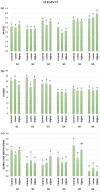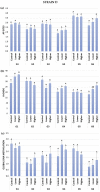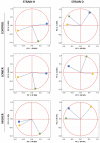Multigenerational Effects of Graphene Oxide Nanoparticles on Acheta domesticus DNA Stability
- PMID: 37629006
- PMCID: PMC10454164
- DOI: 10.3390/ijms241612826
Multigenerational Effects of Graphene Oxide Nanoparticles on Acheta domesticus DNA Stability
Abstract
The use of nanoparticles like graphene oxide (GO) in nanocomposite industries is growing very fast. There is a strong concern that GO can enter the environment and become nanopollutatnt. Environmental pollutants' exposure usually relates to low concentrations but may last for a long time and impact following generations. Attention should be paid to the effects of nanoparticles, especially on the DNA stability passed on to the offspring. We investigated the multigenerational effects on two strains (wild and long-lived) of house cricket intoxicated with low GO concentrations over five generations, followed by one recovery generation. Our investigation focused on oxidative stress parameters, specifically AP sites (apurinic/apyrimidinic sites) and 8-OHdG (8-hydroxy-2'-deoxyguanosine), and examined the global DNA methylation pattern. Five intoxicated generations were able to overcome the oxidative stress, showing that relatively low doses of GO have a moderate effect on the house cricket (8-OHdG and AP sites). The last recovery generation that experienced a transition from contaminated to uncontaminated food presented greater DNA damage. The pattern of DNA methylation was comparable in every generation, suggesting that other epigenetic mechanisms might be involved.
Keywords: 8-OHdG; AP sites; DNA damage; DNA methylation; epigenetics; graphene oxide; invertebrate; multigenerational effects; nanotoxicity; oxidative stress.
Conflict of interest statement
The authors declare no conflict of interest.
Figures







References
-
- Brisebois P.P., Siaj M. Harvesting Graphene Oxide-Years 1859 to 2019: A Review of Its Structure, Synthesis, Properties and Exfoliation. J. Mater. Chem. C Mater. 2020;8:1517–1547. doi: 10.1039/C9TC03251G. - DOI
-
- Smith A.T., LaChance A.M., Zeng S., Liu B., Sun L. Synthesis, Properties, and Applications of Graphene Oxide/Reduced Graphene Oxide and Their Nanocomposites. Nano Mater. Sci. 2019;1:31–47. doi: 10.1016/j.nanoms.2019.02.004. - DOI
-
- Markovic M., Kumar A., Andjelkovic I., Lath S., Kirby J.K., Losic D., Batley G.E., McLaughlin M.J. Ecotoxicology of Manufactured Graphene Oxide Nanomaterials and Derivation of Preliminary Guideline Values for Freshwater Environments. Environ. Toxicol. Chem. 2018;37:1340–1348. doi: 10.1002/etc.4074. - DOI - PubMed
MeSH terms
Substances
Grants and funding
LinkOut - more resources
Full Text Sources

